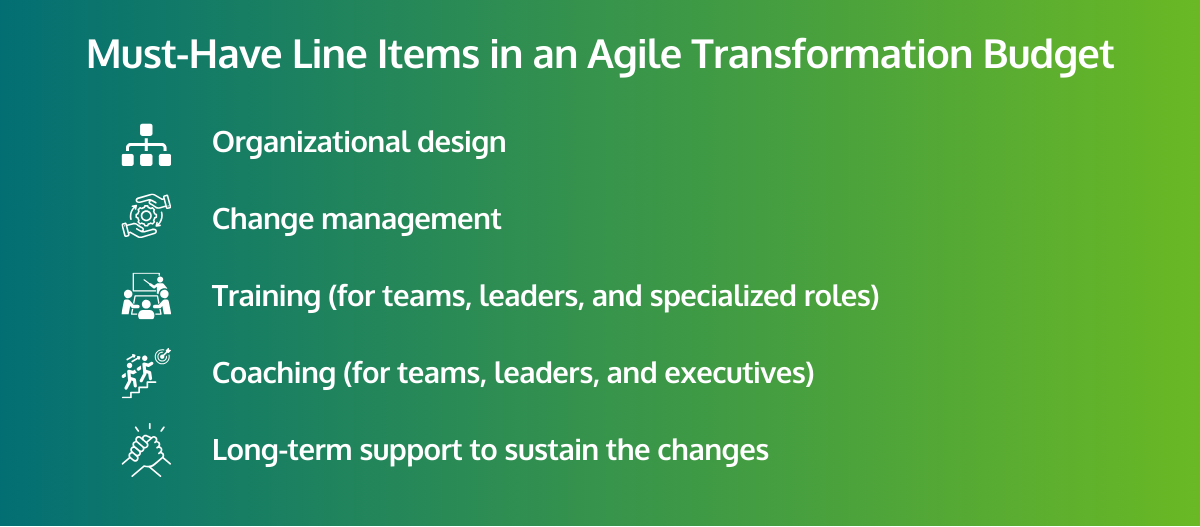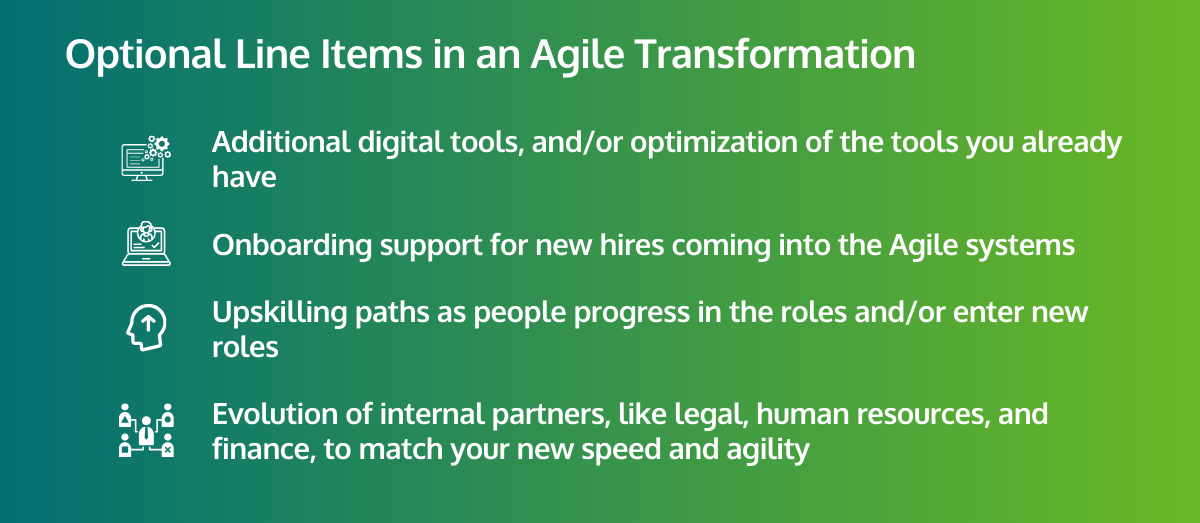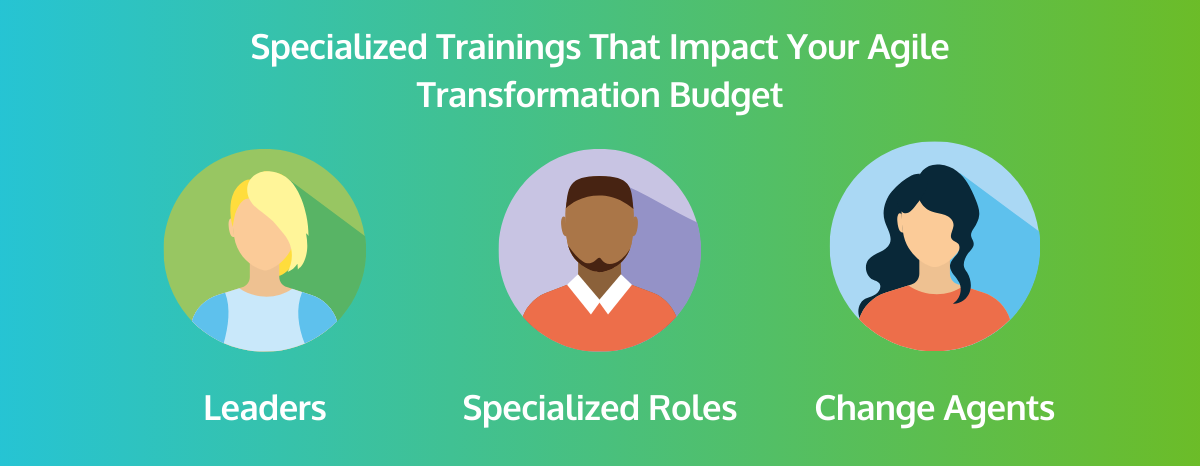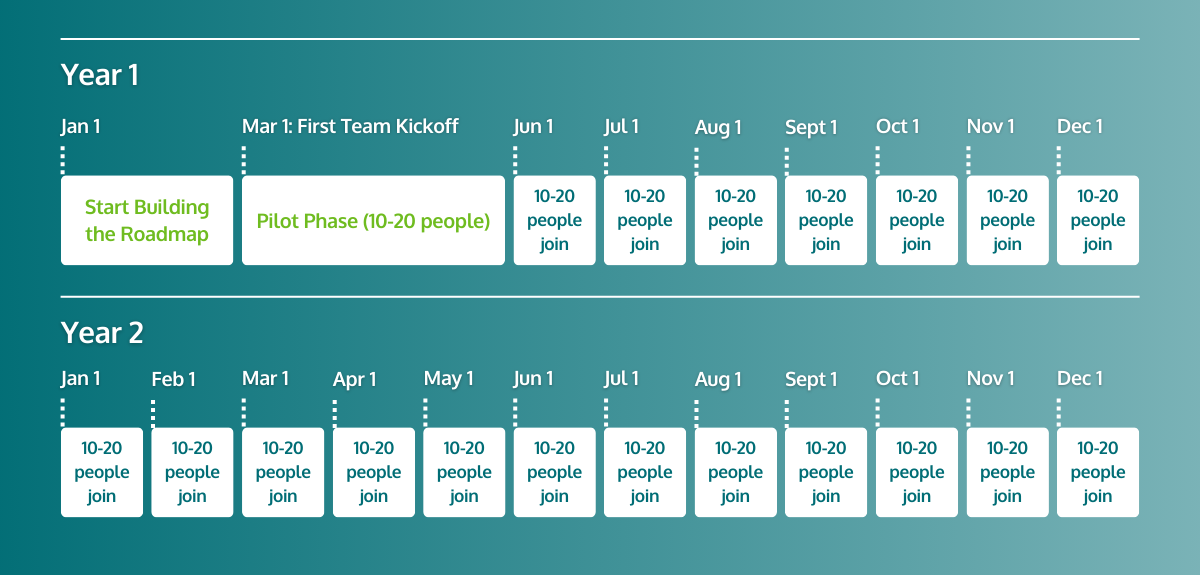Improve your Marketing Ops every week
Subscribe to our blog to get insights sent directly to your inbox.
Confront your process problems head on with a Sherpa by your side.
Explore support options that are tailored to meet you wherever you are on your climb.
Browse our pioneering Agile marketing courses
Learn from the stories of marketers already on the road to process improvement.
Featured Resource

State of Agile Marketing
Learn from 8 years of study on how marketers are increasing their agility.
Download Report
Agile transformations – real ones that deliver game-changing results to an organization – aren’t easy, fast, or cheap. They require serious commitment and investment, which means that when people begin contemplating their own Agile transformation, one of the first questions they ask themselves is, “how much is this going to cost?”
Of course, investing in transformation isn’t like other transactions. It’s not the same as grabbing a gallon of milk from the store, or even like putting a down payment on a house.
But if you consider the most critical factors that influence the bottom line, you should be able to arrive at an estimate of what your Agile transformation is likely to cost you.
Before we get into the meat of this cost analysis, we first need to address one foundational question: are you looking for Agile adoption, or do you really want Agile transformation? Check this article out, If you are not sure what the difference is.
If it’s a real transformation that you’re after, great! Keep reading to assess where you fall on these various factors.
If you’re really in the market for Agile adoption, that’s also great. You’ll just need to start differently. I recommend this quick Introduction to Agile Marketing course, which should orient you and help you map out your next few steps.
And now, on to the factors that influence transformation costs.
Over the course of a complete Agile transformation, you’ll be working on a lot of different parts and pieces. You can’t just put everyone through a 1-day workshop and declare victory; you’ll need to invest in:

Cutting out any of these components increases your risk of failure exponentially. So that means you’ll need to plan and budget for all of them at various times.
Depending on what else you have already in place, you might also need:

Take note! There’s a difference between the first list and the second. The first list is a collection of best practices that nearly every good transformation includes. The second list is more conditional – you might need them and you might not. So for the purposes of this article, we’ll be focusing mostly on the first list.
Knowing now what the must-have pieces are, let’s figure out how much each one costs.
To begin answering the cost question, we first need to know the scope of our transformation effort. I recommend starting with the biggest possible number of people, and working down from there.
So if your marketing organization has 100 people in it total, but you know you want to start with a pilot group of 15-20, go ahead and start budgeting for the full 100. If you can get the bulk of your full budget earmarked, it’s far easier to carve out some of it for a pilot and come back to the rest later than to continually keep asking for more budget as the transformation progresses. You don’t want a big procurement delay right when your new Agile teams are getting some momentum!

Beyond the raw number of affected people, you’ll also want to consider the different learning journeys people will take. Your senior leaders and executives don’t need to go through all the nitty gritty fundamentals courses, but they will need training on how to plan and budget differently in an Agile environment, as well as how to evolve their leadership styles more broadly.
If you only train individual contributors but still have leaders expecting perfect deliverables instead of MVPs, you’re setting up some serious conflicts.
Any transformation partner that you consider should be able to provide specialized training and coaching for senior leaders and executives. Here’s a typical leadership curriculum that you can use as a reference.
Likewise, make sure an Agile coach has experience working with leaders in particular; it’s very different working with an Agile team to apply key practices than it is to guide an executive as they work to lead in a completely different way.
A good rule of thumb is that anyone with direct reports will need this kind of specialized training, and senior leaders (those who manage managers and above on your org chart) will need additional executive coaching. While this kind of coaching and training will be more expensive than the basic training your individual contributors need, you’ll only have to budget for a small fraction of people to go through it.
Depending on the Agile framework you choose, you may need some new supporting roles. While traditional Agile calls for a very particular approach to these roles (especially if you’re using the Scrum framework), marketers often need something more nuanced.
That might be a true Agile coach, a hybrid of the Product Owner and Scrum Master roles (we call this a Team Lead at AgileSherpas), and/or a Marketing Owner. Whatever their title and job description, these roles are critical to empower teams and keep your Agile transformation going.
This means the people you’re asking to step into these roles need a higher level of coaching and training than their colleagues, just like senior leaders. Again, this will come at a higher price point than basic training, but you’ll only need to send a fraction of your people through it.
Good options to consider for these roles are workshops on Agile facilitation, how to be a Scrum Master and/or Product Owner, and/or Agile coaching.
For budgeting purposes, and to create some redundancy in the event that someone leaves, I recommend getting 1.5-2 people training on these specialized roles per Agile team. So if we have a 100-person transformation being planned, 15-20 people should be familiar with Agile roles and how to perform them.
Before checking out the supporting drivers of the transformation, why don't you have a look at an Agile Transformation checklist?
Last, but certainly not least, you need to support the internal change champions who’ll be driving the transformation forward. These people will be in the trenches day in and day out for at least 18 months, and they’re going to need help.
If you have champions who haven’t ever been through an Agile transformation before, that’s doubly true.
This doesn’t have to be a massive line item in your transformation budget, but make sure you get a couple of hours per week with a strategic consultant as part of your overall transformation package. Your change agents will need a sounding board to talk through the unpredictable bumps that inevitably come up, and you don’t want to be caught without access to that expertise.
The next factor you need to consider when calculating the costs of an Agile transformation is how quickly you want to move. This includes how fast you want to get your pilot team(s) up and running, as well as how fast you want the transformation to be “done.”
(Of course, Agile transformations are never really finished, so “done” here really means that all the Agile teams have been launched.)
In most cases, you’re going to be paying more for speed. Good Agile coaches and consultants are in high demand. Many will be booked up for months into the future, so getting started within 30-60 days is going to be tough. If that’s important to you, be prepared to pay more up front to expedite their availability.
Likewise, if you’re keen on hitting a particular “end date” when all your teams will be fully up to speed on Agile ways of working, you may need to budget a bit more to make it happen.
Assuming our 100-person transformation again, we need about 60 days to put together a transformation roadmap. Then an average speed would be 90 days to train, launch, and test pilot teams. After that, another 1-2 teams of 10 people would come online every 30-60 days.
That means if we started building the roadmap on January 1, the first team kicks off around March 1. Then the pilot phase (10-20 people) would end around June 1, and we’d have another 10-20 joining the Agile army every month.

At that pace we’d have 100% adoption by early in the fourth quarter if we’re launching two teams per month; if we’re going slower and only doing one team per month, it may take us till the second quarter of the following year.
A faster pace puts more pressure on the system, and requires more monitoring by consultants and coaches, so be prepared if you want to push things beyond this typical timeline.
The next component to consider is how far away your organization is from the Agile ideal you want to move toward. If an Agile transformation feels more like an iteration – meaning you’re not too far away from real agility – then you may be able to pull back on some of the more basic line items in your transformation budget, like introductory workshops.
If, on the other hand, you know Agile ways of working are a really, really long way from how you work today, you’ll want to budget for additional coaching to help people make it through the change.
Remember, Agile adoption and Agile transformation aren’t the same thing. Transformation takes more time and effort, and if that’s your ultimate goal you need to be prepared to support people throughout that journey.
Just like a longer road trip demands a higher number of stops to refuel and stock up on snacks, a longer transformation trip will require more budget for coaching, consulting, and other supporting activities.
Last but not least, some organizations have existing Agile resources that they can leverage during a transformation effort. An Agile center of excellence (CoE), or even just existing Agile roles (such as Scrum Masters) may be able to cut down on your total Agile transformation costs.
But, a word of caution: supporting teams from software development or IT while they apply Agile day to day (the typical role of a Scrum Master) is nothing like leading or managing an Agile transformation.
It’s unfair to expect Scrum Masters with no expertise in transformation to drive that kind of complex, long-term initiative.
So by all means, lean on internal agilists wherever you can find them. Just make sure that you’re asking them to support in a way that matches their skill set. That means, if you’ve got internal resources, you’ll be reducing some training costs around specialized roles, and maybe some team-level coaching costs, but many of the strategic, consultative costs will remain unaffected.
As the length of this article implies, most Agile transformations require a hefty investment. That means the second question most people ask is, “When will I recoup this investment?”
In other words, what’s the potential ROI on an Agile transformation?
While everyone’s experience is a little different, we’ve developed a standardized formula to help figure this out for AgileSherpas’ clients. Here’s a real life (but anonymized) example we developed in partnership with an internal change champion:
|
Value Theme |
Estimated Annual ROI |
|
Employee engagement benefit |
$7,370 |
|
Productivity improvement |
$1,775,078 |
|
Improved customer satisfaction |
$1,203,885 |
|
Faster time to market |
$2,604,558 |
|
Total Annual ROI |
$5,590,890 |
Over the course of their multi-year transformational journey, this client will invest around $850,000 each year. But they’ll recoup $5.5 million every single year in the form of productivity gains, employee engagement, customer satisfaction, and faster time to market.
So the short answer for them was the potential ROI in just the first year is $4,740,890 (although realistically this full benefit probably won’t show up until the second year, as this data assumes the entire marketing function is using Agile ways of working).
If you’d like to get your own customized ROI estimate, drop me a line here.
Whatever your own ROI possibilities, remember that you’ll need to consider the following items when budgeting for your Agile transformation:
Cross reference those with answers to following questions to get your own budget:
With all that said, before you leave, be sure to get our Agile Marketing Transformation Checklist to assess how ready you are for a potential transformation. Good luck!

Andrea Fryrear is a co-founder of AgileSherpas and oversees training, coaching, and consulting efforts for enterprise Agile marketing transformations.
Subscribe to our blog to get insights sent directly to your inbox.
Subscribe to our blog to get insights sent directly to your inbox.